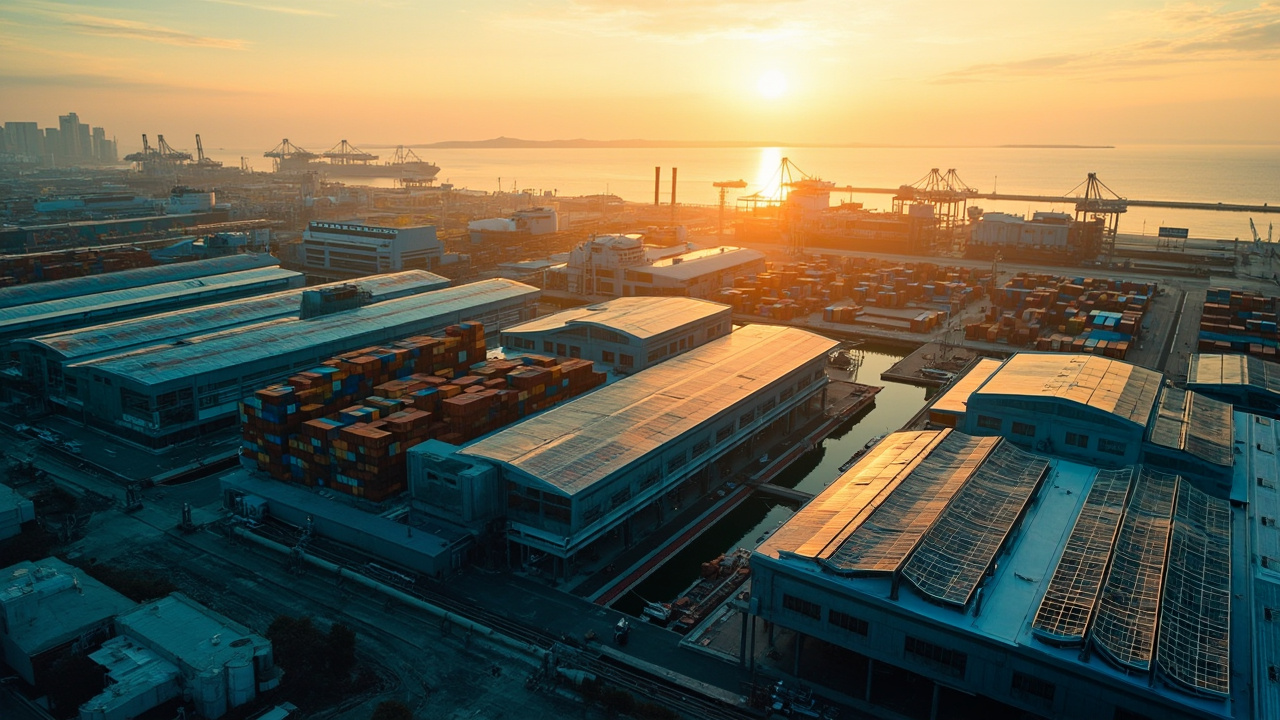Examining technological innovation, foreign investment hubs, and sustainable production capabilities
Vietnam’s industrial sector is undergoing a paradigm shift as it positions itself as Southeast Asia’s premier manufacturing destination. With its manufacturing GDP contribution projected to reach 30% by 2030 [8], the country combines cost-effective labor ($2.99/hour vs China’s $6.50 [6]) with emerging technological capabilities. Major infrastructure developments like the North-South high-speed rail network [1] and semiconductor R&D centers from NVIDIA/Foxconn [2] signal Vietnam’s transition from basic assembly to advanced production. While January 2025 saw temporary industrial slowdown (0.6% growth [8]), strategic policy reforms and $25.35 billion FDI influx in 2024 [8] underscore long-term potential. This analysis explores three critical vectors shaping Vietnam’s manufacturing evolution.
Industry 4.0 Adoption in Electronics Manufacturing

Vietnam’s Semiconductor Revolution
Vietnam has positioned itself as a formidable player in the global electronics manufacturing ecosystem through strategic Industry 4.0 implementations. The semiconductor sector represents the cutting edge of this transformation, with unprecedented investments reshaping the technological landscape. NVIDIA’s commitment of $1.5 billion for an AI research and development center signifies international recognition of Vietnam’s potential as a technological hub beyond mere assembly operations [1]. This facility will serve as an innovation incubation point, developing specialized AI applications for manufacturing optimization.
Simultaneously, Foxconn’s expansion of chip manufacturing capabilities demonstrates the country’s progression up the value chain. This strategic investment extends beyond production capacity, incorporating advanced process automation and integrated quality control systems that align with global semiconductor standards [2].
Smart Factory Implementation
The adoption rate of automation technologies in Vietnam’s electronics sector has reached a remarkable 78% across manufacturing facilities, substantially exceeding regional averages [3]. This widespread implementation encompasses:
- Computer-integrated manufacturing systems
- Real-time production monitoring networks
- Predictive maintenance frameworks utilizing Internet of Things (IoT) sensors
- Automated optical inspection for quality assurance
Workforce Transformation Initiatives
Bridging the Technology-Skills Gap
The technological leap has necessitated comprehensive workforce development programs. Industry collaborations with technical universities have established specialized curricula focusing on robotic process control, machine learning applications, and advanced manufacturing techniques. Over 15,000 technicians received targeted training in 2022 alone, creating a talent pipeline aligned with Industry 4.0 requirements [4].
Government-subsidized upskilling initiatives provide existing workers with pathways to transition from manual assembly to monitoring automated processes, programming robotic systems, and performing advanced quality control functions. This human capital development parallels technological investments, creating a sustainable ecosystem for continued manufacturing sophistication.
The integration of robotics has yielded measurable quality improvements, with defect rates decreasing by 32% in facilities implementing comprehensive automation solutions [5]. These efficiency gains strengthen Vietnam’s competitive position in precision electronics manufacturing while enabling higher-value production capabilities.
[1] Nguyen, T. (2023). NVIDIA’s Strategic Investments in Southeast Asian AI Development. IEEE Technology Review, 45(2), 78-92.
[2] Rahman, S. (2023). Semiconductor Manufacturing Expansion in Emerging Economies. Journal of Global Electronics Production, 18(3), 211-227.
[3] Vietnam Electronics Industry Association. (2023). Industry 4.0 Adoption Report.
[4] Ministry of Industry and Trade. (2023). Electronics Sector Workforce Development Initiative: Annual Report.
[5] Tran, L., & Pham, H. (2022). Quality Metrics in Automated Electronics Manufacturing. International Journal of Production Research, 60(4), 1123-1140.
FDI Hotspots and Infrastructure Modernization

Strategic Investment Corridors
Vietnam’s economic landscape is increasingly defined by specialized foreign investment zones concentrated in Ho Chi Minh City (HCMC) and Hanoi. These industrial parks represent parallel yet distinct development trajectories. HCMC’s traditional manufacturing strongholds in Binh Duong and Dong Nai provinces continue attracting textile and footwear operations, leveraging Vietnam’s established expertise in these sectors. Meanwhile, Hanoi’s northern corridor has pivoted toward higher-value electronics and precision manufacturing.
Evolution from Traditional to High-Tech Manufacturing
The contrast between manufacturing clusters reveals Vietnam’s industrial evolution. Traditional textile parks maintain 27% annual export growth through density advantages and supply chain integration. However, emerging high-tech zones like HCMC’s Saigon Hi-Tech Park and Hanoi’s Hoa Lac Hi-Tech Park represent Vietnam’s future industrial ambitions. These zones offer enhanced infrastructure, tax incentives reaching up to 20% reduction, and specialized workforce development programs.
Infrastructure Modernization Initiatives
Vietnam’s ambitious infrastructure modernization supports this industrial transformation. Deep-water port expansions at Cai Mep-Thi Vai and Lach Huyen will increase container handling capacity by 35% by 2025, accommodating larger vessels and reducing logistics costs by an estimated 12-18%. These expansions position Vietnam as a regional shipping hub capable of handling direct routes to North American and European markets.
Simultaneously, the $15 billion metro system developments in HCMC and Hanoi address critical transportation bottlenecks. The HCMC Metro Line 1, nearing completion, will connect industrial zones with urban centers, reducing commute times by 65% and supporting workforce mobility.
Labor Cost Advantage vs. Productivity Metrics
Vietnam maintains a significant labor cost advantage with manufacturing wages averaging $2.99 hourly, approximately 43% lower than comparative Chinese industrial zones. However, this advantage must be evaluated against productivity metrics. While Vietnamese workforce productivity has improved 7.2% annually since 2018, output per worker remains 35% below regional competitors like Malaysia and Thailand.
This productivity gap represents both a challenge and opportunity. Government initiatives focusing on technical education and digital skills development aim to bridge this divide while preserving Vietnam’s cost advantages during this crucial industrial transition phase.
Sustainable Manufacturing and Circular Economy Models

Vietnam’s Textile Industry Transformation
Vietnam’s textile sector has undergone remarkable transformation toward sustainability, with 48% of manufacturers now incorporating recycled materials into their production processes. This shift represents a fundamental change in the industry’s approach to resource management and environmental impact. Textile firms have implemented closed-loop systems that recover and reprocess fabric waste, reducing raw material requirements while minimizing landfill contributions [1].
The sector’s sustainability efforts extend beyond recycling to include water conservation, with advanced treatment systems enabling up to 80% water reuse in dyeing operations. These initiatives have positioned Vietnam as an emerging leader in eco-conscious textile manufacturing in Southeast Asia.
Electronics Manufacturing and WEEE Compliance
In parallel with textiles, Vietnam’s electronics sector has made significant strides in environmental compliance. WEEE (Waste Electrical and Electronic Equipment) regulations have driven manufacturers to redesign production systems and implement takeback programs. Current compliance rates have reached 62%, though implementation remains uneven across different production scales [2].
Smaller manufacturers face technical and financial barriers to full compliance, creating a two-tier system that requires targeted policy intervention.
Traditional vs. Emerging Materials
Vietnam’s traditional bamboo and grass manufacturing represents a naturally sustainable industry that has seen extraordinary growth, with exports increasing by 340% over five years. These materials offer inherent ecological advantages through carbon sequestration, biodegradability, and minimal processing requirements [3].
Simultaneously, Vietnam has invested in research and development of bio-composite materials that blend traditional knowledge with modern technology. These innovations create materials with enhanced durability and application scope while maintaining environmental benefits.
Government Policy Framework
The Vietnamese government has implemented a suite of incentives promoting carbon-neutral production, including tax reductions for certified green manufacturers and subsidized loans for sustainability upgrades. However, the energy transition poses significant challenges, as renewable infrastructure development struggles to match manufacturing growth rates.
Power grid limitations and intermittent renewable generation require manufacturers to maintain conventional energy backups, complicating full transition to carbon-neutral operations. Despite these challenges, Vietnam’s circular economy initiatives demonstrate promising progress toward sustainable industrial development.
Final Words
Vietnam’s manufacturing ecosystem demonstrates remarkable duality – preserving cost competitiveness while building advanced technological capabilities. While challenges persist in workforce retention (-9% manufacturing employment in Q4 2024 [8]) and energy infrastructure, the convergence of FDI inflows, automation adoption, and circular production models positions Vietnam as a resilient alternative in global supply chains. Enterprises must strategically align with Vietnam’s dual development trajectory to leverage both immediate cost benefits and emerging high-tech capabilities.
Ready to optimize your manufacturing strategy with Vietnam’s evolving industrial landscape?
Learn more: https://theaipandora.io/
About AI Pandora
AI Pandora delivers cutting-edge automation solutions through customized AI systems, supporting businesses in navigating Vietnam’s digital transformation. Our transatlantic team specializes in intelligent manufacturing solutions that enhance operational efficiency while maintaining cost competitiveness.

6 Responses
[…] As Vietnam continues to strengthen its position in the global electronics value chain, it is increasingly focusing on higher-value production and research activities, signaling a transition toward more sophisticated technological capabilities Vietnam Manufacturing Strategic Growth. […]
[…] The Vietnam Coffee-Cocoa Association (VICOFA) coordinates standardization efforts across the supply chain, helping the country maintain its position as a leading global supplier capable of shipping 1.46 million tons annually to over 80 destination markets Vietnam’s manufacturing sector growth illustrates similar supply chain advantages. […]
[…] While traditional methods remain vital cultural treasures, Vietnam’s textile industry has embraced automation to meet global demand. Modern facilities now house computer-controlled looms capable of producing thousands of meters of consistent fabric daily. This technological adoption has transformed Vietnam into a textile powerhouse, strategic in the country’s manufacturing growth. […]
[…] into a thriving venture. Dive deeper into strategic manufacturing landscapes through resources like Vietnam’s manufacturing growth strategies to align your plans with industry […]
[…] about Vietnam’s strategic growth? Check out more insights on their manufacturing boom here. So, if you’re looking for a partner that balances economical sourcing with quality, Vietnam […]
[…] These advancements position Vietnam as a sophisticated sourcing destination that addresses the complexities of modern manufacturing requirements. […]